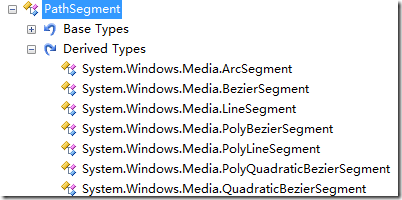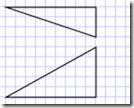PathGeometry可以创建任意的2D图形形状。
其内部通过PathSegment集合来实现
如画2个三角形
<Path Stroke="Black" StrokeThickness="1"><Path.Data><PathGeometry><PathGeometry.Figures><PathFigureCollection><PathFigure IsClosed="True" StartPoint="10,100"><PathFigure.Segments><PathSegmentCollection><LineSegment Point="100,100" /><LineSegment Point="100,50" /></PathSegmentCollection></PathFigure.Segments></PathFigure><PathFigure IsClosed="True" StartPoint="10,10"><PathFigure.Segments><PathSegmentCollection><LineSegment Point="100,10" /><LineSegment Point="100,40" /></PathSegmentCollection></PathFigure.Segments></PathFigure></PathFigureCollection></PathGeometry.Figures></PathGeometry></Path.Data></Path>

外边框和笔刷均由Path提供,Geometry只负责绘制形状
为简化上面xaml,wpf提供了路径语法解析器,由
性能更好的StreamGeometry
不管Shape,Geometry还是Segment,其提供的熟悉均是依赖属性,所以其提供了依赖属性相关的特性,绑定和动画.
若Shape不用xaml表示,而是提供一个画图的DrawRectangle等方法,提供参数传递,那么可能就没必要提供依赖属性提供支持了.这样就回归到原始画法,从而了提高了性能
如下示例,StreamGeometryContext 提供了所有Segment的方法,可以猜测StreamGeometryContext 也是对Segment对象属性的一种封装,直接调用方法则省去了Segment集合的对象以及Segment内部的依赖属性来提供性能.
var g = new StreamGeometry();using (StreamGeometryContext context = g.Open()){context.BeginFigure(new Point(100,100), false, false);context.LineTo(new Point(200, 100), true, false);context.LineTo(new Point(200, 200), true, false);context.LineTo(new Point(100, 100), true, false);context.BeginFigure(new Point(300, 200), false, false);context.LineTo(new Point(400, 200), true, false);//context.LineTo(new Point(500, 200), true, false);//context.LineTo(new Point(200, 100), true, false);}
真正绘图的对象
FrameworkElement并不提供任何绘制图形的能力,其只是为绘图提供了必要的数据.即自上而下的封装.
Rectangle=>Create RectangleGeometry=>调用DrawingContext的DrawRoundedRectangle
若不提供Geometry,DrawingContext内部则会再次创建Geometry.
WPF的元素就是通过一个个FrameworkElement结合DrawingContext为基础,结合WPF各项特性搭积木而成,所以性能不好的时候就请查看visual tree的数量吧.

